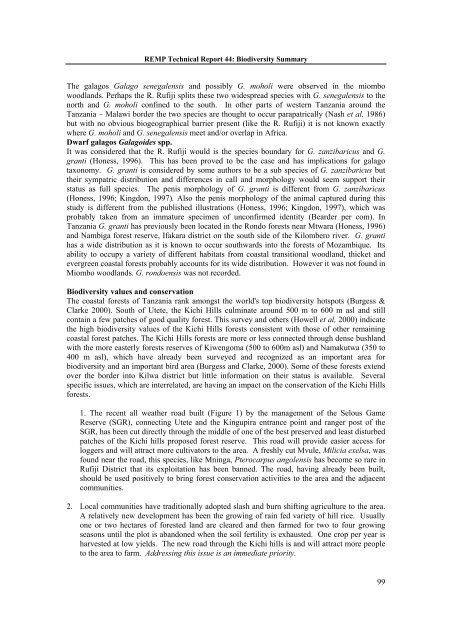Family / Scientific name - Coastal Forests of Kenya and Tanzania
Family / Scientific name - Coastal Forests of Kenya and Tanzania
Family / Scientific name - Coastal Forests of Kenya and Tanzania
Create successful ePaper yourself
Turn your PDF publications into a flip-book with our unique Google optimized e-Paper software.
REMP Technical Report 44: Biodiversity Summary<br />
The galagos Galago senegalensis <strong>and</strong> possibly G. moholi were observed in the miombo<br />
woodl<strong>and</strong>s. Perhaps the R. Rufiji splits these two widespread species with G. senegalensis to the<br />
north <strong>and</strong> G. moholi confined to the south. In other parts <strong>of</strong> western <strong>Tanzania</strong> around the<br />
<strong>Tanzania</strong> – Malawi border the two species are thought to occur parapatrically (Nash et al, 1986)<br />
but with no obvious biogeographical barrier present (like the R. Rufiji) it is not known exactly<br />
where G. moholi <strong>and</strong> G. senegalensis meet <strong>and</strong>/or overlap in Africa.<br />
Dwarf galagos Galagoides spp.<br />
It was considered that the R. Rufiji would is the species boundary for G. zanzibaricus <strong>and</strong> G.<br />
granti (Honess, 1996). This has been proved to be the case <strong>and</strong> has implications for galago<br />
taxonomy. G. granti is considered by some authors to be a sub species <strong>of</strong> G. zanzibaricus but<br />
their sympatric distribution <strong>and</strong> differences in call <strong>and</strong> morphology would seem support their<br />
status as full species. The penis morphology <strong>of</strong> G. granti is different from G. zanzibaricus<br />
(Honess, 1996; Kingdon, 1997). Also the penis morphology <strong>of</strong> the animal captured during this<br />
study is different from the published illustrations (Honess, 1996; Kingdon, 1997), which was<br />
probably taken from an immature specimen <strong>of</strong> unconfirmed identity (Bearder per com). In<br />
<strong>Tanzania</strong> G. granti has previously been located in the Rondo forests near Mtwara (Honess, 1996)<br />
<strong>and</strong> Nambiga forest reserve, Ifakara district on the south side <strong>of</strong> the Kilombero river. G. granti<br />
has a wide distribution as it is known to occur southwards into the forests <strong>of</strong> Mozambique. Its<br />
ability to occupy a variety <strong>of</strong> different habitats from coastal transitional woodl<strong>and</strong>, thicket <strong>and</strong><br />
evergreen coastal forests probably accounts for its wide distribution. However it was not found in<br />
Miombo woodl<strong>and</strong>s. G. rondoensis was not recorded.<br />
Biodiversity values <strong>and</strong> conservation<br />
The coastal forests <strong>of</strong> <strong>Tanzania</strong> rank amongst the world's top biodiversity hotspots (Burgess &<br />
Clarke 2000). South <strong>of</strong> Utete, the Kichi Hills culminate around 500 m to 600 m asl <strong>and</strong> still<br />
contain a few patches <strong>of</strong> good quality forest. This survey <strong>and</strong> others (Howell et al, 2000) indicate<br />
the high biodiversity values <strong>of</strong> the Kichi Hills forests consistent with those <strong>of</strong> other remaining<br />
coastal forest patches. The Kichi Hills forests are more or less connected through dense bushl<strong>and</strong><br />
with the more easterly forests reserves <strong>of</strong> Kiwengoma (500 to 600m asl) <strong>and</strong> Namakutwa (350 to<br />
400 m asl), which have already been surveyed <strong>and</strong> recognized as an important area for<br />
biodiversity <strong>and</strong> an important bird area (Burgess <strong>and</strong> Clarke, 2000). Some <strong>of</strong> these forests extend<br />
over the border into Kilwa district but little information on their status is available. Several<br />
specific issues, which are interrelated, are having an impact on the conservation <strong>of</strong> the Kichi Hills<br />
forests.<br />
1. The recent all weather road built (Figure 1) by the management <strong>of</strong> the Selous Game<br />
Reserve (SGR), connecting Utete <strong>and</strong> the Kingupira entrance point <strong>and</strong> ranger post <strong>of</strong> the<br />
SGR, has been cut directly through the middle <strong>of</strong> one <strong>of</strong> the best preserved <strong>and</strong> least disturbed<br />
patches <strong>of</strong> the Kichi hills proposed forest reserve. This road will provide easier access for<br />
loggers <strong>and</strong> will attract more cultivators to the area. A freshly cut Mvule, Milicia exelsa, was<br />
found near the road, this species, like Mninga, Pterocarpus angolensis has become so rare in<br />
Rufiji District that its exploitation has been banned. The road, having already been built,<br />
should be used positively to bring forest conservation activities to the area <strong>and</strong> the adjacent<br />
communities.<br />
2. Local communities have traditionally adopted slash <strong>and</strong> burn shifting agriculture to the area.<br />
A relatively new development has been the growing <strong>of</strong> rain fed variety <strong>of</strong> hill rice. Usually<br />
one or two hectares <strong>of</strong> forested l<strong>and</strong> are cleared <strong>and</strong> then farmed for two to four growing<br />
seasons until the plot is ab<strong>and</strong>oned when the soil fertility is exhausted. One crop per year is<br />
harvested at low yields. The new road through the Kichi hills is <strong>and</strong> will attract more people<br />
to the area to farm. Addressing this issue is an immediate priority.<br />
99

















